DIY Kid’s Craft Table
In need of a functional kid’s craft table but can’t justify the price tag? We made our own kid’s craft table that’s the perfect size for little hands, has tons of storage, and is budget-friendly! Find a full tutorial, including a materials list, in this post!
I’m taking a break from Christmas decor to share one of my favorite DIYs from the Shared Boys’ Bedroom we completed a few weeks ago – a DIY kid’s craft table!
I knew I wanted to have a specific space in their room designated for coloring, crafting and just making.
I also needed a place to hold their crayons, markers, and the boatloads of Play-Doh and assorted Play-Doh tools. Their coloring books needed a permanent home that wasn’t my dining room table or the floor.
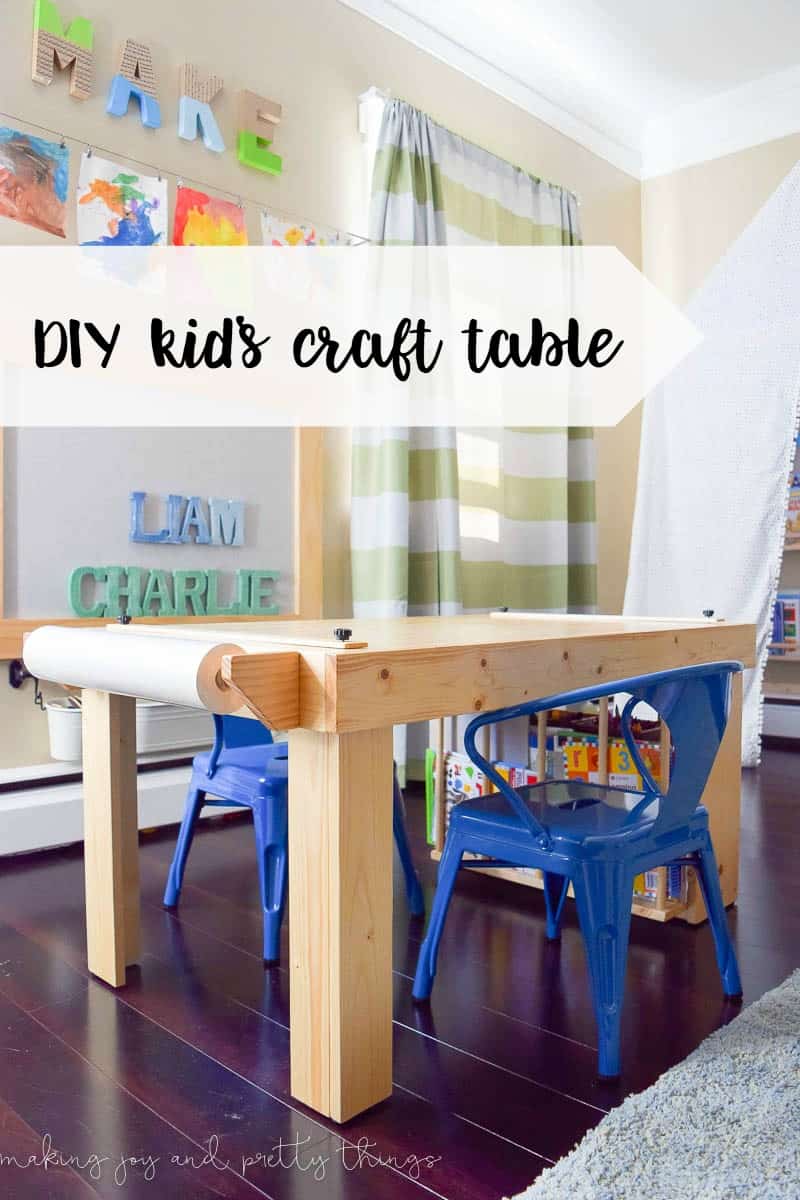
I scoured the internet searching for a budget-friendly kid’s table only to be disappointed by how costly they could be! I’m talking several hundred dollars. I simply couldn’t justify spending that!
So, I designed my own table from the couple I really liked online. I needed storage for coloring books and shelves to store their other “making” supplies. And I knew I wanted a paper roll that could be pulled across the top for easy coloring.
I set off to draw my design and went to show my FIL. He, being CRAZY awesome, agreed to make my little table!
Oh, and he agreed to write this post, too! Talk about the best guy, ever.
So, with that, I’m turning my little blog over to him to give the full tutorial on our kid’s craft table!
Building Plans for a Kids Craft Table
Every project needs a detailed, precise, drawn-to-scale blueprint, right? Yikes!
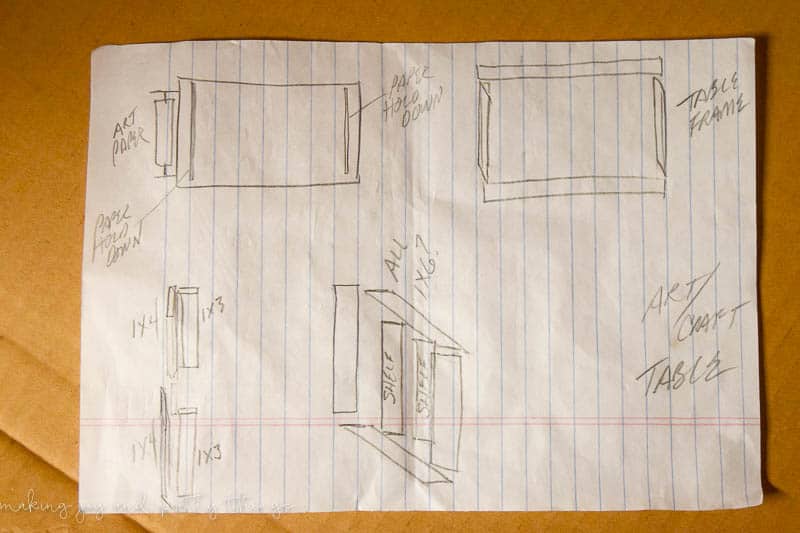
How to Build a Kids Craft Table
Kids Craft Table: List of Tools & Materials + What They’re Used For
- 2’ x 4’ preassembled laminated pine project panel (tabletop)
- 1” x 4” pine boards (tabletop apron, legs, book holder, paper holder brackets)
- 3/8” x 1½” pine slats (backstops for storage shelves)
- 1” x 8” pine board (storage shelf assembly)
- 1” x 2” pine board (storage shelf assembly)
- ¾” round dowel (paper holder)
- ½” round dowel (book holder)
- ¼” x 1½” poplar slats (paper hold downs)
- ¼” threaded insert nut (paper hold downs)
- ¼” threaded knobs (paper hold downs)
- Rubber no-slip grips (leg bottoms)
- Wood glue
- Minwax Natural wood stain
- Polycrylic satin water-based wood finish
- Circular saw
- Table saw
- Miter saw
- Orbital sander
- 150 & 220 grit sandpaper
- Tack cloth
- Sanding cloths
- Kreg pocket hole jig
- Pocket hole screws
- Pocket hole plugs
- Drill driver
- 1/2″ Forstner bit
- Square
Since we were looking for a rustic look (isn’t everybody?), we chose to use regular common pine boards, complete with the knots, checks, and other imperfections. You know, the good stuff!
You could choose to go with a better grade of clear pine or even a different species like oak (if stain is desired) or poplar (good for painting).
Tabletop Assembly
We cut the tabletop panel down to the desired 42” length with the table saw. We only cut off 6 inches, so you could keep it at 48″ if you prefer.
Next cut the 1×4 pine boards to length to create an apron to surround the tabletop.
After sanding the surface and edges of the boards, we attached them to the tabletop using a bead of wood glue and Kreg pocket holes in each corner and around the perimeter of the table top.
The pocket screws create a very strong joint that is virtually invisible since the fasteners are installed on the underside of the boards, out of sight.
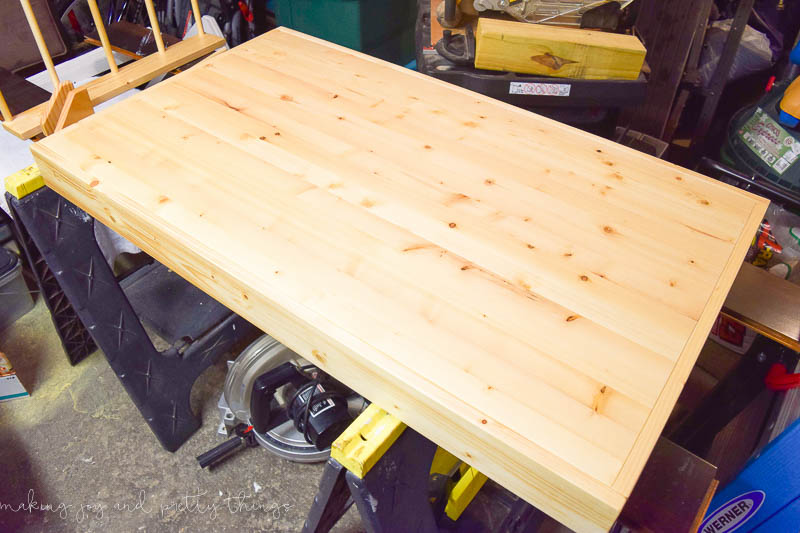
Instructions for Individual Components of the Kids Craft Table
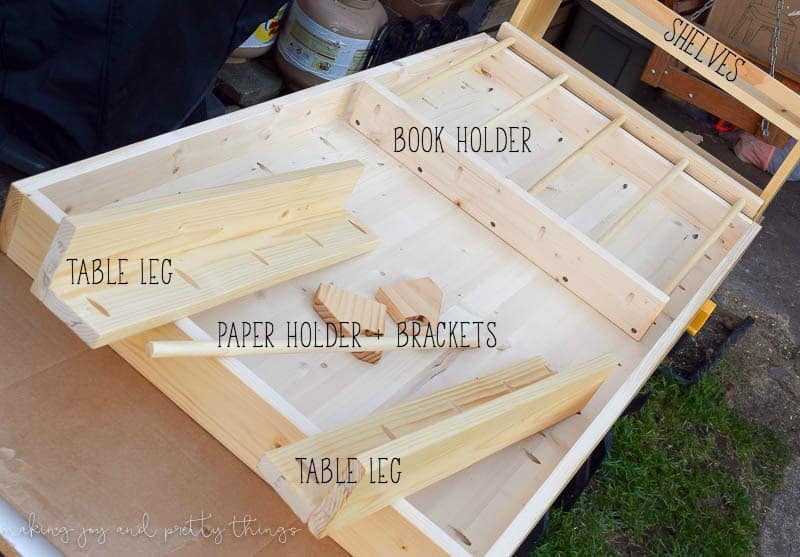
1. Table Legs
Having determined the finished height of the table, we cut four pieces of 1×4 boards to length to create the two legs of the table.
The other side of the kids craft table is held up by the shelves instead of legs.
Two of the 1×4 boards were cut down to a width of 2¾” each with the table saw, then attached to the other 1×4 boards using 5 Kreg pocket holes, forming two “L” shaped legs with equal width sides.
Next, fill the pocket holes on the legs with wooden plugs and wood glue. Once dry, sand the legs and the plugs smooth.
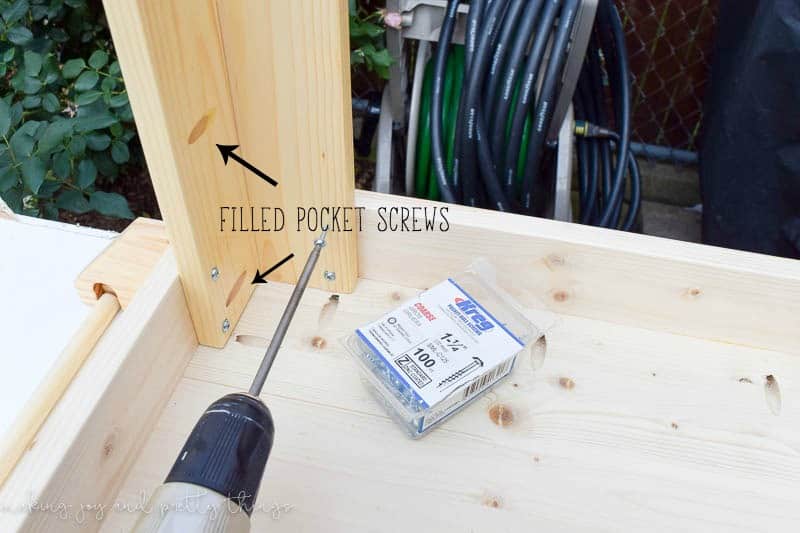
2. Side Shelving
The side shelving unit has two shelves perfect for crayons, markers, and Play-Doh. It also serves as the legs of the kids craft table on one side.
Cut the sides of the shelving from a 1×8 board to the same length as the table legs.
We cut the two shelves from the remaining 1×8 board and used pocket screws to attach them between the 1×8 side panels.
The bottom shelf sits on two 1×2 boards, set back about ½” from the front and back of the leg.
Each shelf gets a “backstop” made from a ½” x 1 ½” pine slat, to keep the storage bins from sliding off the back of the shelves.
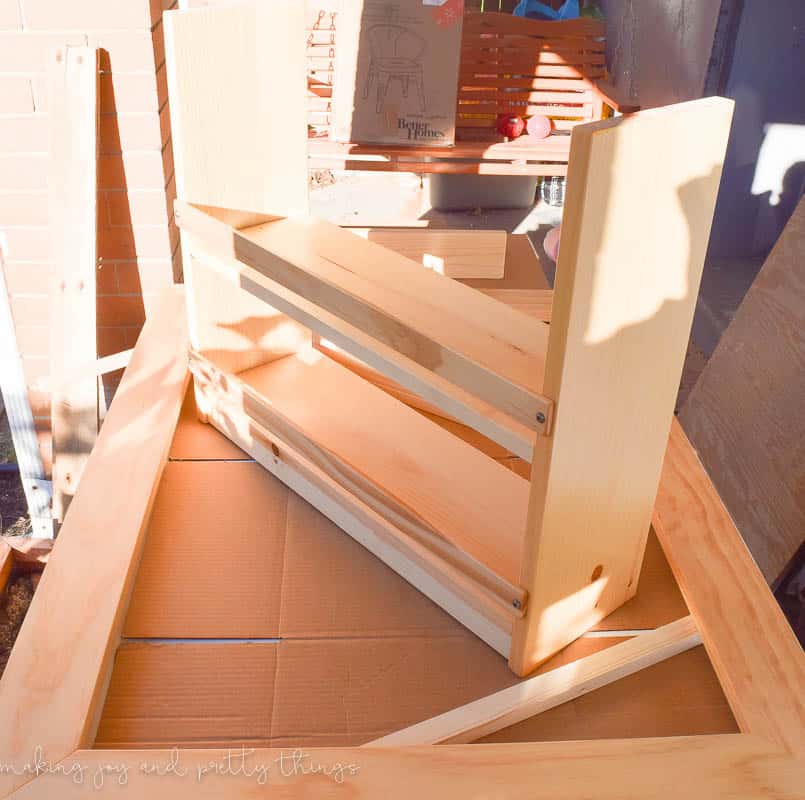
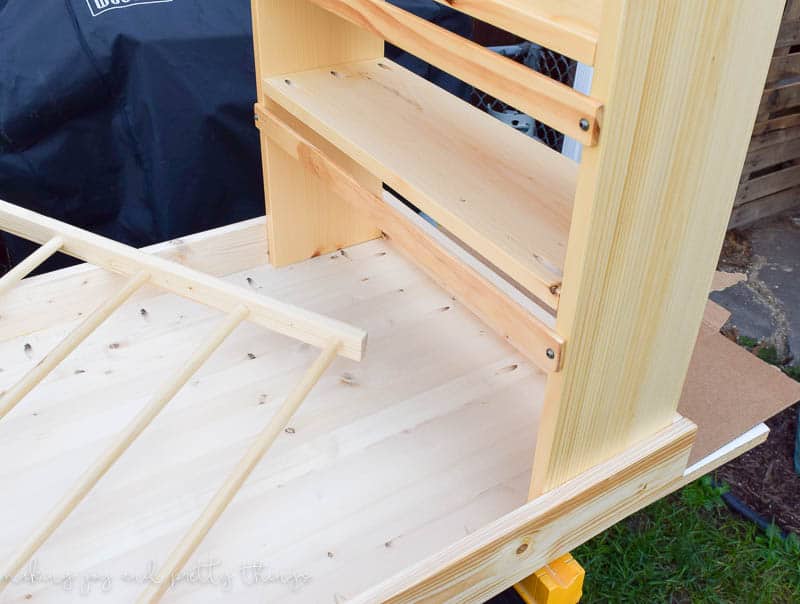
3. Book Holder
We started the bookholder by cutting a 1×4 board to length for the bottom and a 1×2 board for the top.
We decided to fit the bottom between the two 1×8 legs of the shelving unit, where it would slip under the ½” overhang of the bottom storage shelf.
Laying the top and bottom boards side by side, we drew locator lines evenly spaced across both boards. This allowed us to pinpoint where holes would be drilled to accept the ends of five ½” dowel rods. These dowel rods will serve as the side of the book holder.
Using a ½” Forstner bit, drill five sets of holes for the five dowels, each ½” deep. The Forstner bit drills a clean-edged, flat-bottomed hole. Perfect!
Then, we cut the five 1/2″ dowels to length with the miter saw and glued them into place on both boards.
Here’s the completed end shelf assembly with the book holder attached.
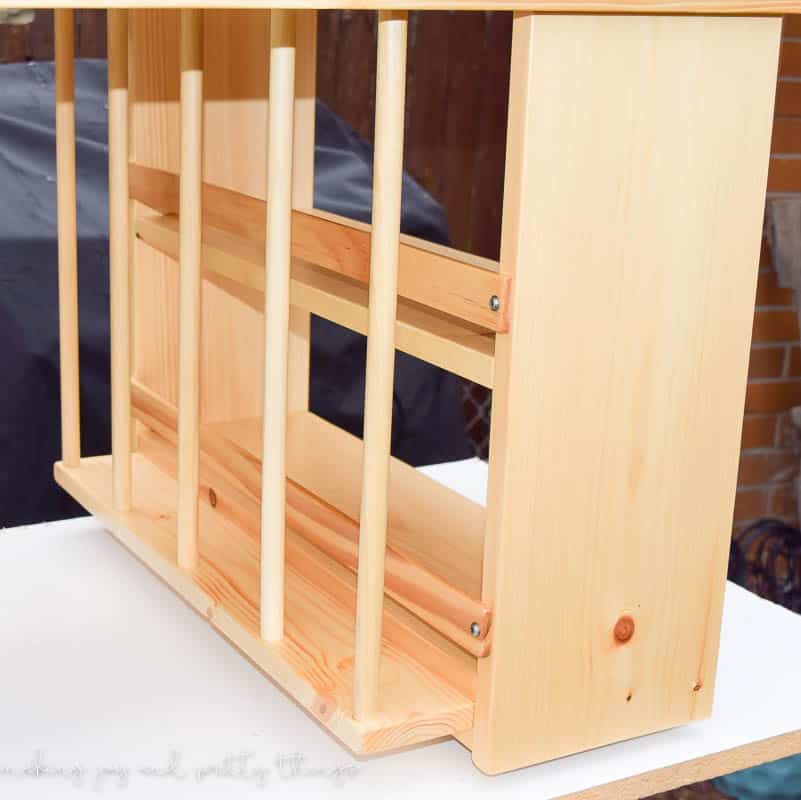
4. Paper Holder
The paper holder consists of a couple of short lengths of 1×4 pine and a ¾” dowel.
For aesthetics, and with little heads in mind, we clipped the bottom corner of the paper supports.
We routed grooves into the inside surfaces of the supports to accommodate a ¾” dowel rod. Cut the rod long enough to hold the paper roll plus a little excess on each end of the roll.
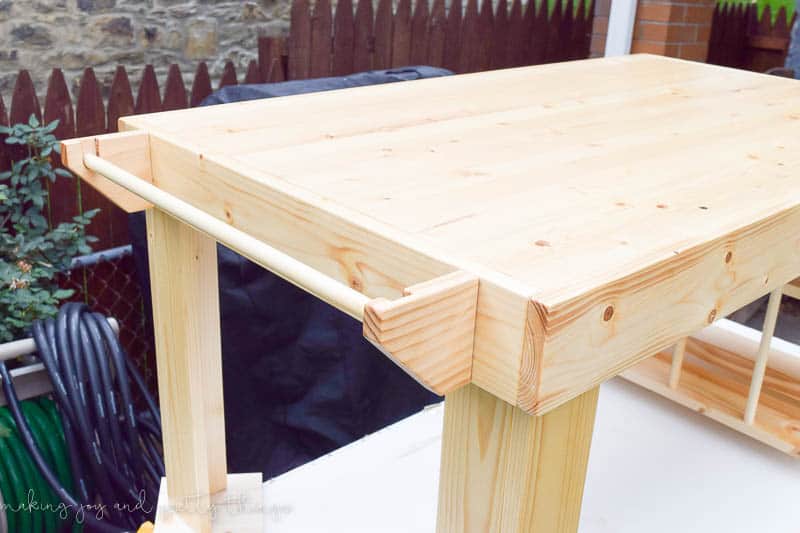
5. Paper Hold Downs
We fashioned paper hold-downs on the top of the table out of ¼” x 1 ½” slats. Then, we determined a length that would be long enough to cover the width of the paper and allow room for the hold-down knobs.
Drill holes slightly larger than the threaded insert nut of the tightening knobs on each end of the slats.
After placing the slats on the tabletop in the desired final position, transfer the location of the holes in the slats to the tabletop by tracing through the holes with a pencil.
Next, drill holes into the tabletop at those points for the brass threaded inserts.
There was a lot of trial and error with the size of these holes. They needed to be bigger than expected!
Once you get the sizing right, you can drill the remaining holes into the tabletop to accept the threaded inserts.
It helps to add a bit of painter’s tape to the drill bit to the depth of the hole being drilled. When you get to the tape, the hole is as deep as you want it to be.
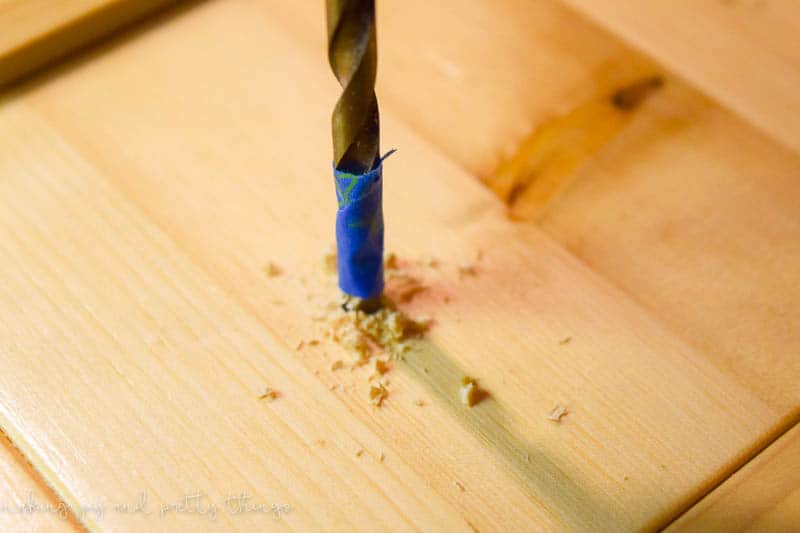
Next, turn the threaded insert nuts into the hole until flush with the top of the table.
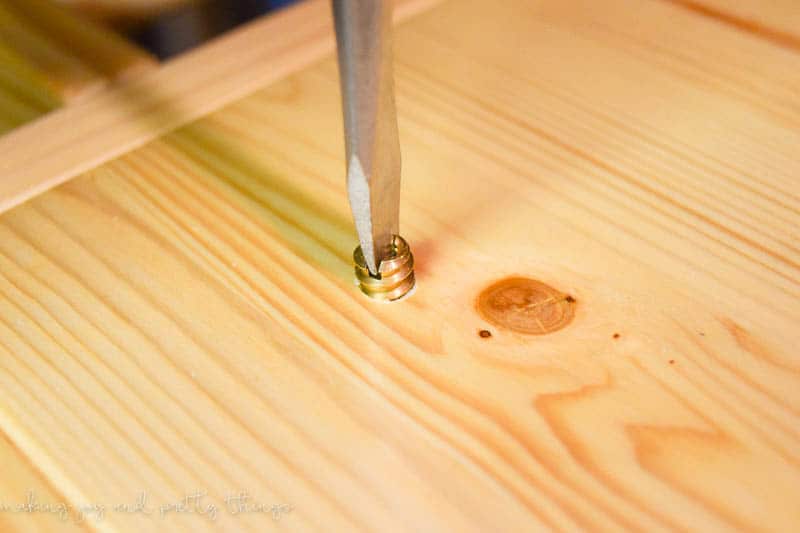
Here’s a look at the components of the paper hold-downs:
- the installed threaded insert nut
- the 1/4″ x 1 1/2″ wooden slat with a hole drilled slightly larger than the thread on the hold-down knob
- the threaded knob itself
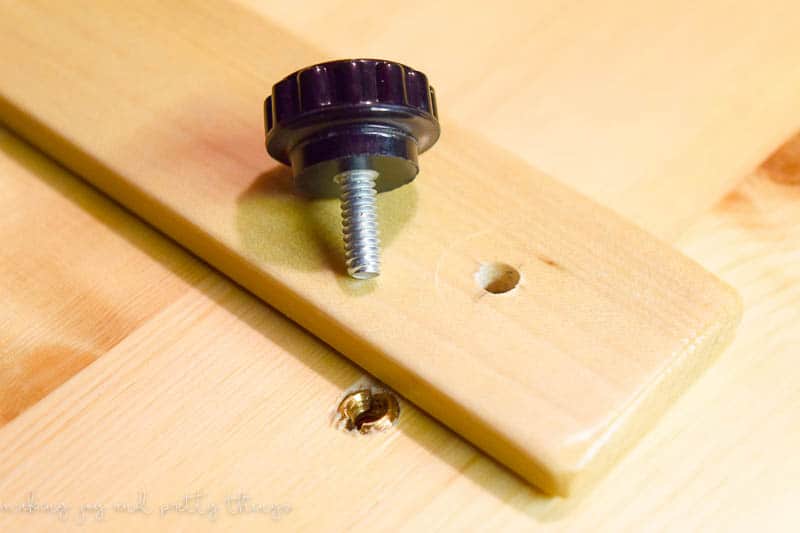
Next, take your threaded knobs and feed them through the holes in the slats, then turn them into the inserts until the slats are snug to the table.
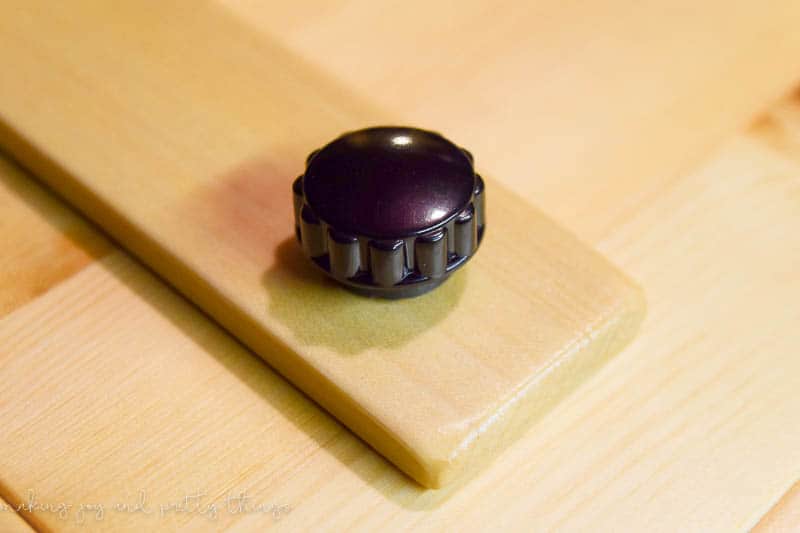
Final Assembly of the Kids Crafting Table
Once we had all the individual components constructed, it was time to assemble them into the final kids craft table!
First, sand all surfaces smoothly and round the corners over slightly. Start with 150-grit sandpaper and work up to 220-grit.
Then brush off and wipe the wood with a tack cloth before applying a natural wood stain and multiple coats of satin finish Polycrylic.
To make things easier, we applied the finishes to the leg and shelf assemblies as they were completed, and to the top and apron after everything was assembled. Then everything got a final coating of Polycrylic just to be sure!
Attaching the Table Legs
First, we screwed the legs to the inside of the table apron.
We decided to use screws only – no wood glue – to allow for future removal.
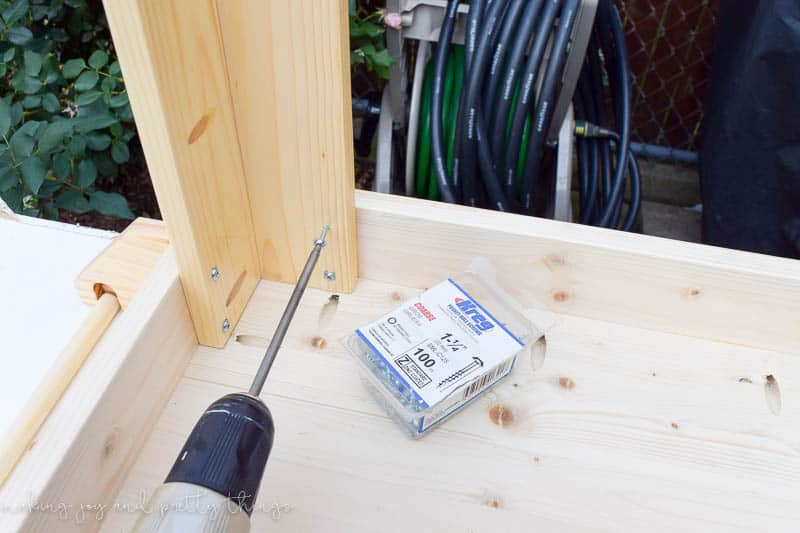
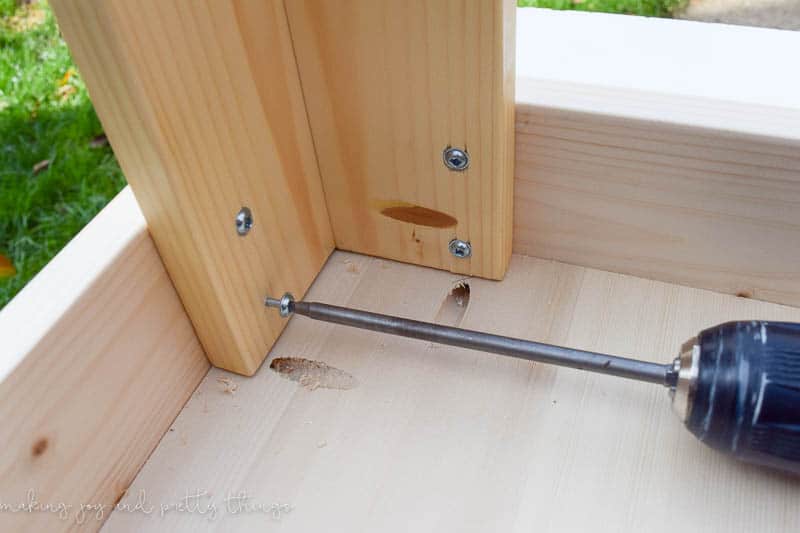
Attaching the Side Shelves
The shelving unit is attached to the inside of the apron boards using 1 1/4″ coarse-threaded Kreg screws.
We squared up the end shelf assembly to the tabletop before driving home the 3 fastening screws.
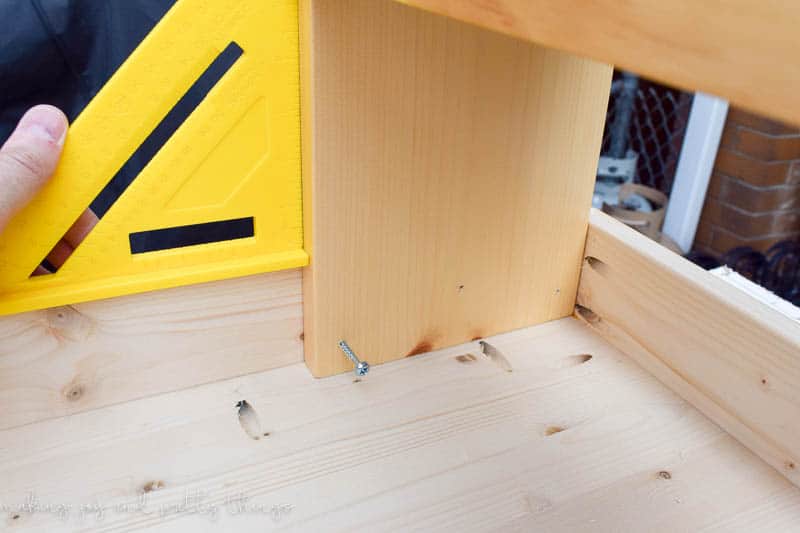
The entire bookholder assembly is attached to the back of the storage shelves (using pocket screws), and to the underside of the tabletop using 1 1/4″ Kreg screws.
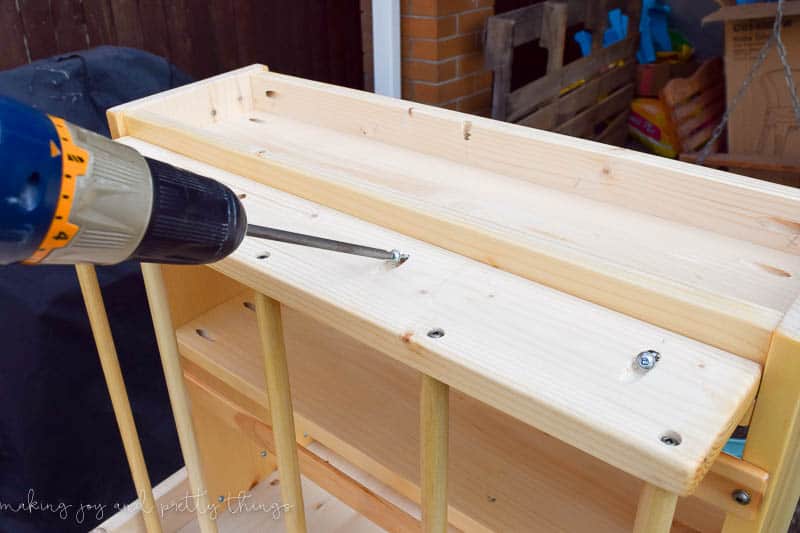
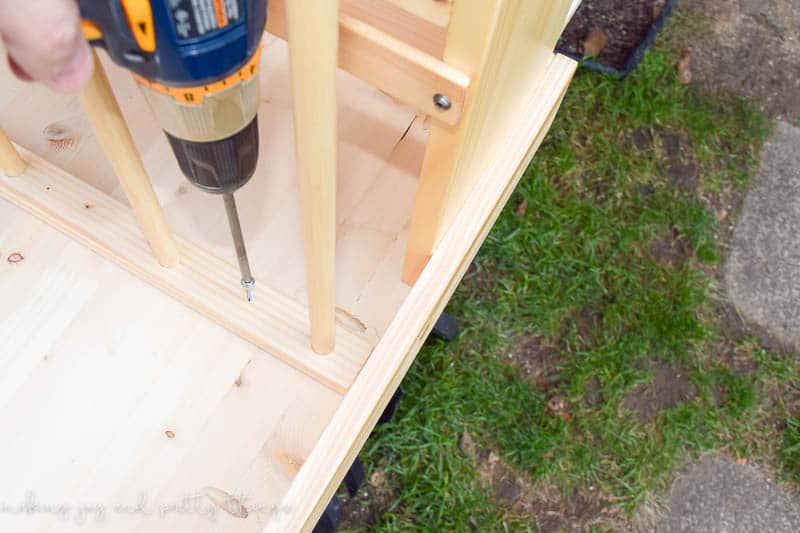
Attaching the Paper Holder
For the paper holder, we drilled pilot holes through the table apron. Then, we glued and screwed the supports into place.
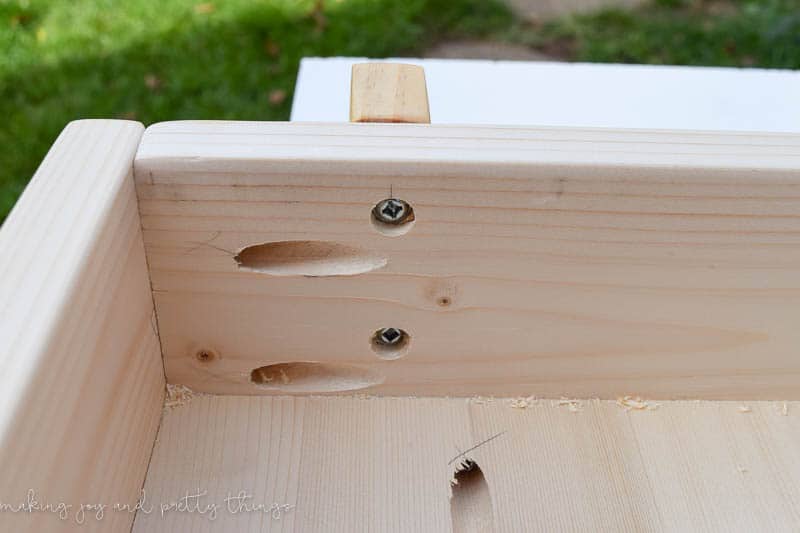
Getting there! Completed paper holder assembly!
We used a router to create the groove in each bracket to hold the 3/4″ dowel in place.
Adding the paper roll is as easy as lifting the dowel up and out of the grooves, and then dropping it back in!
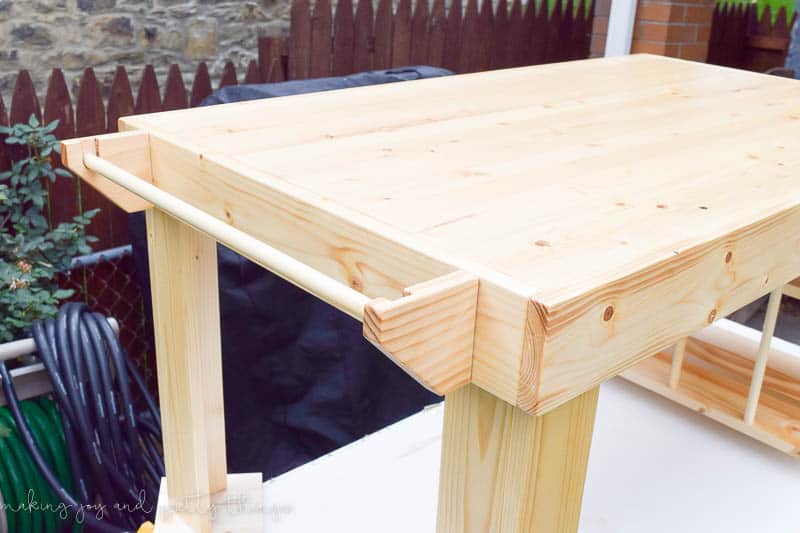
Adding Anti-Sleep Feet
Last, we added rubber anti-slip feet to the bottoms of the legs. They will help to keep the table in place during furious crayoning and hand painting!
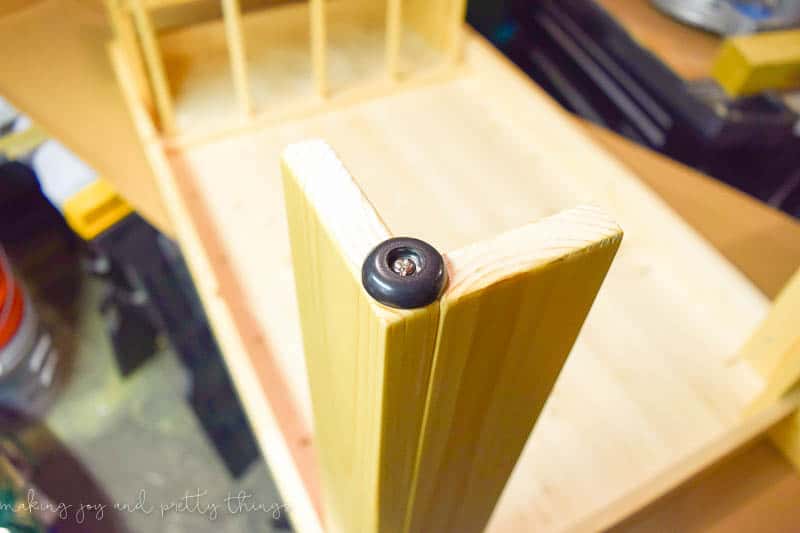
The Finished Product: A DIY Kids Craft Table!
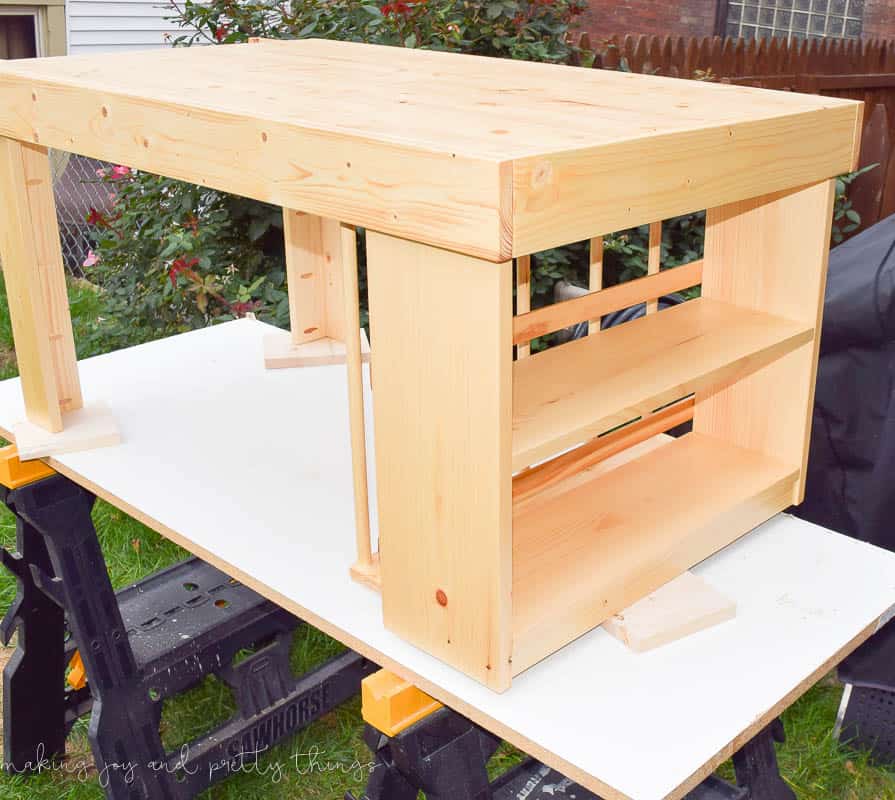
And, here’s the finished kids craft table in place in the boys’ bedroom!
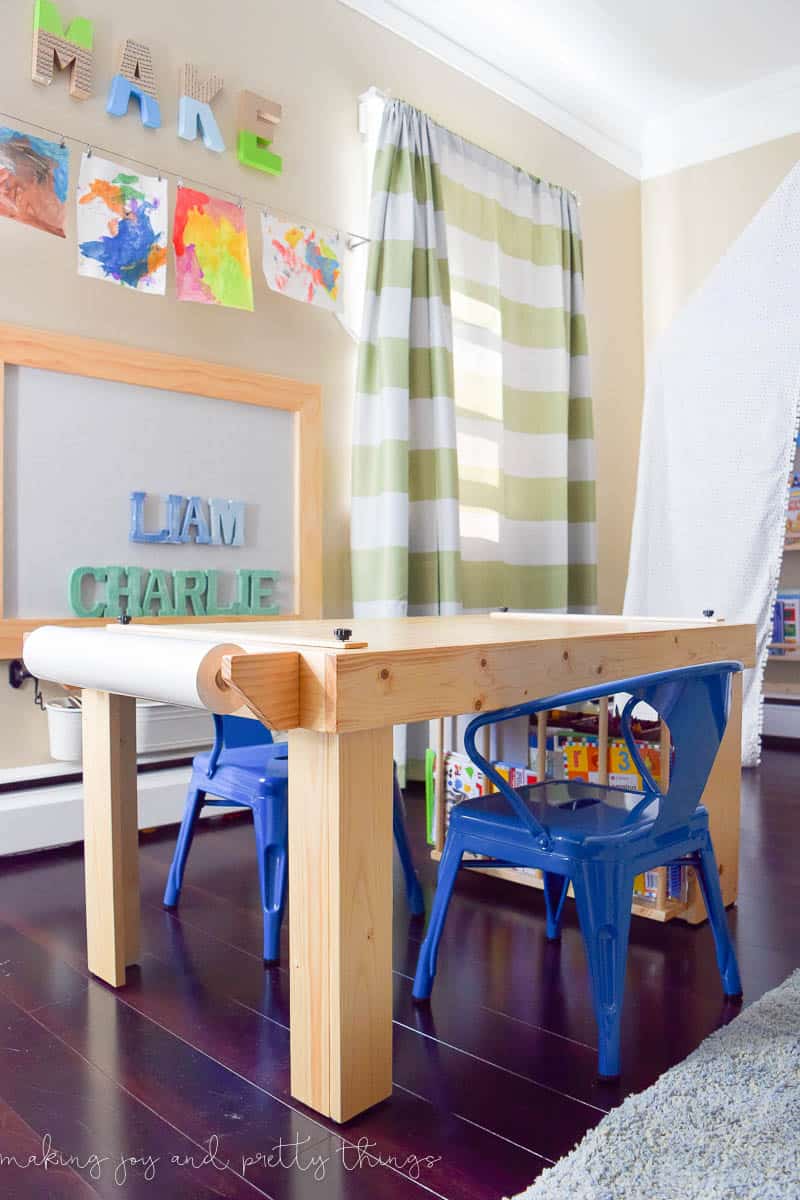
The shelves are the perfect height for little bins of crayons, markers, and Play-Doh supplies. And, the perfect height for little hands to reach (and clean up!!).
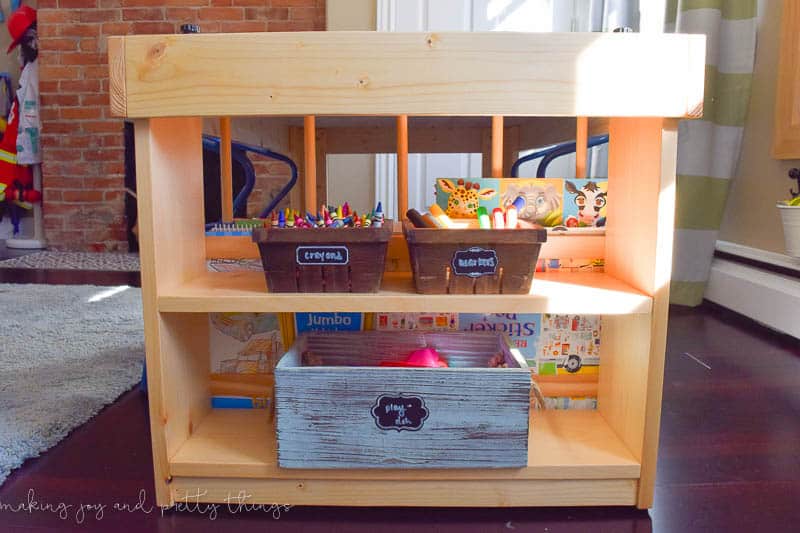
The paper roll is one of my favorite parts of the table. It’s so easy to loosen the paper holds on the table, roll a bit under, and secure the paper to the table. The kids can freely draw and color whatever they’d like.
I often leave the same section up for a while. I love seeing what they come back and add to their little drawings. It’s completely open-ended!
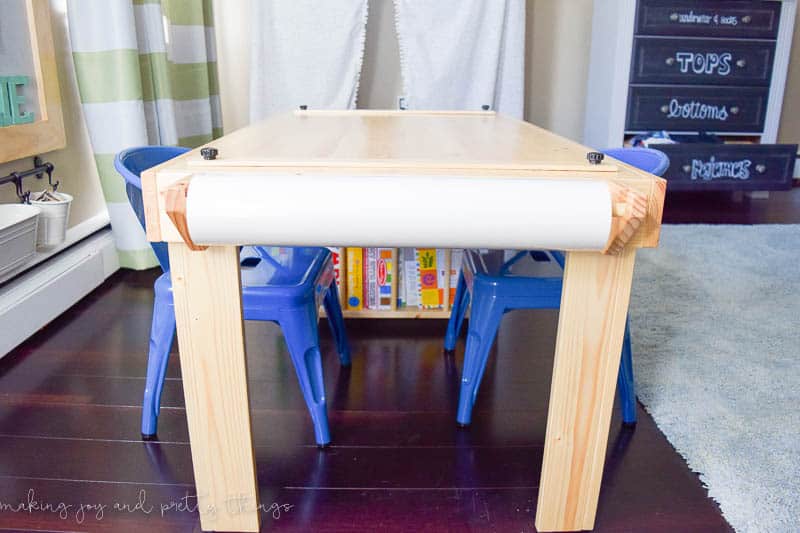
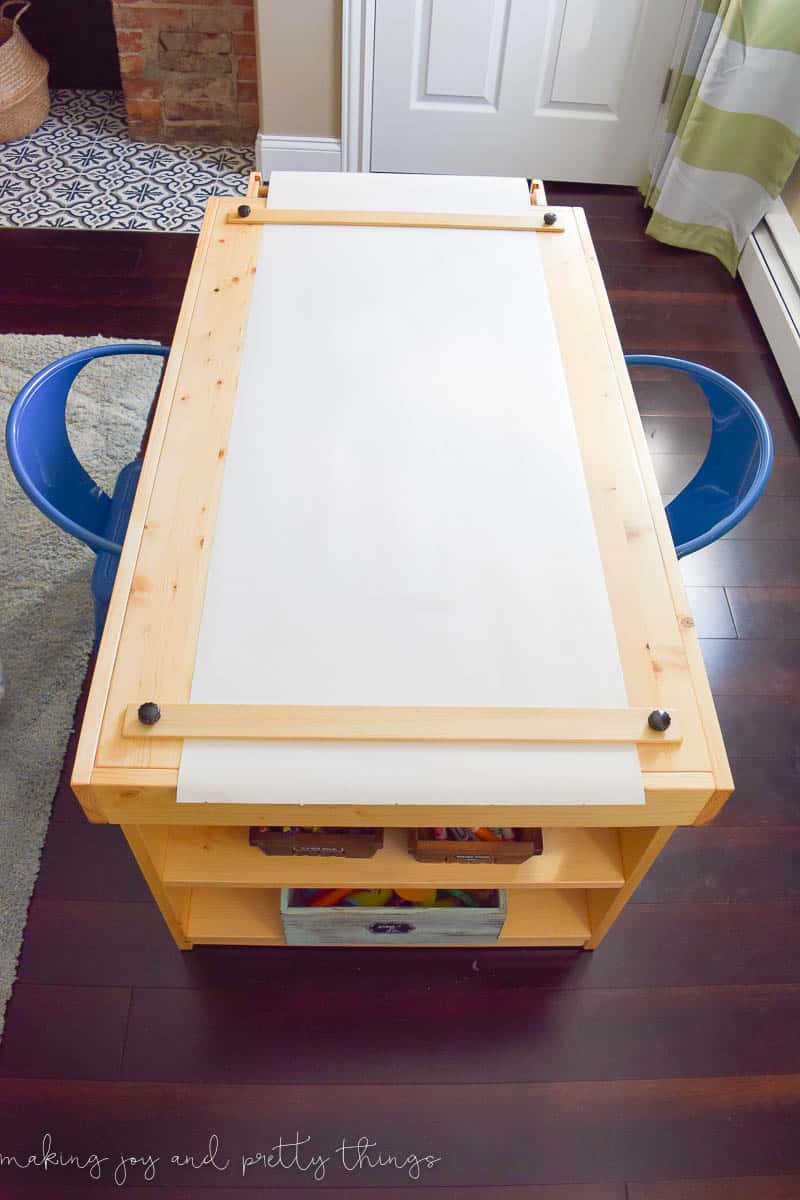
The kid-size metal chairs (similar option here) are the perfect size for both boys, with room to grow. Plus, they’re really, really cute!
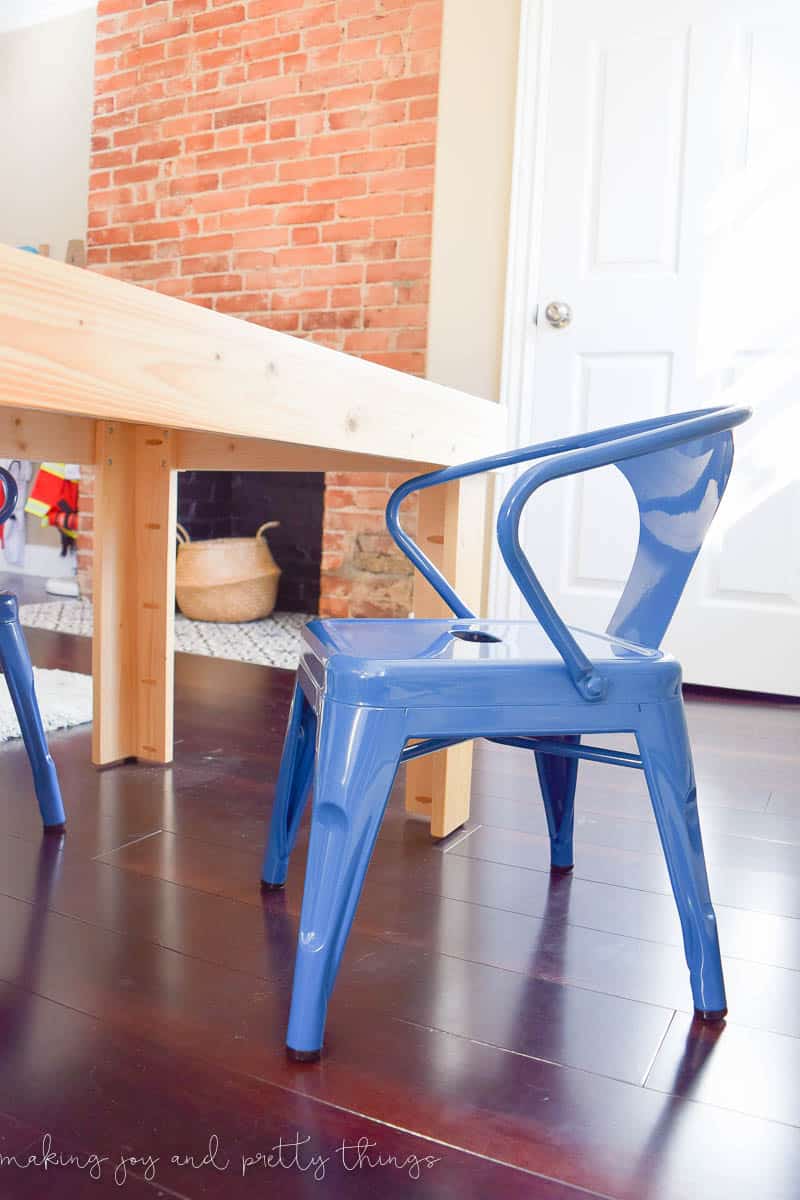
Finally, the coloring book holder fits ALL of their books, which is entirely too many, of course.
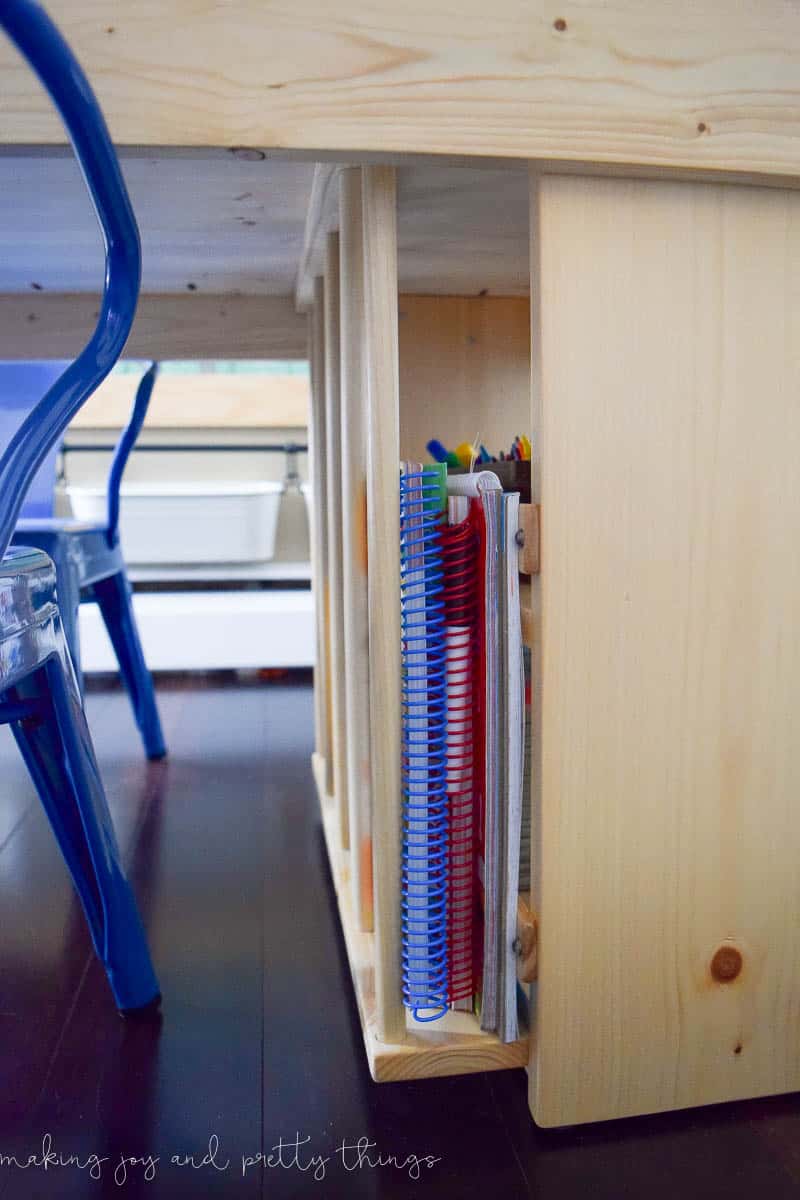
While I love the style and function of the table, the kiddos are thrilled about it, too!
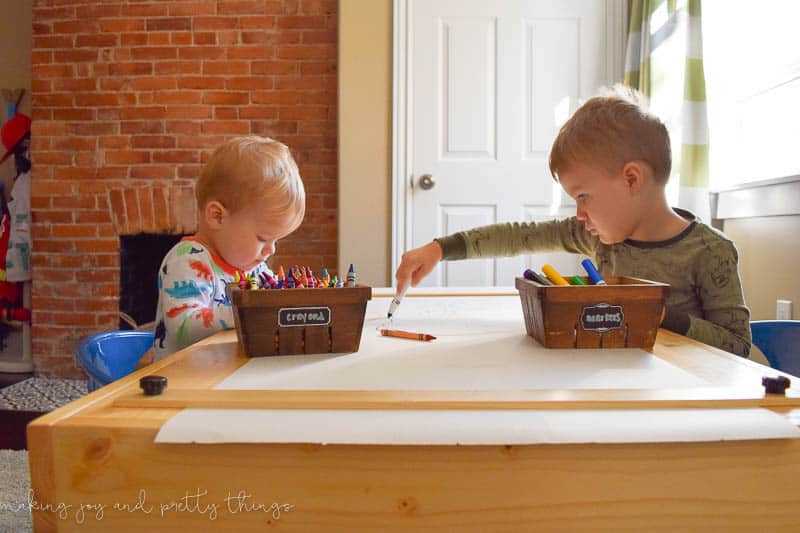
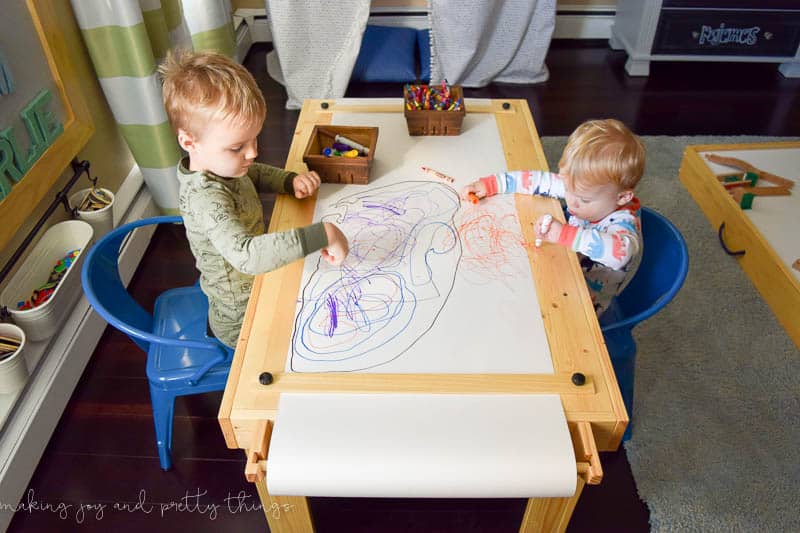
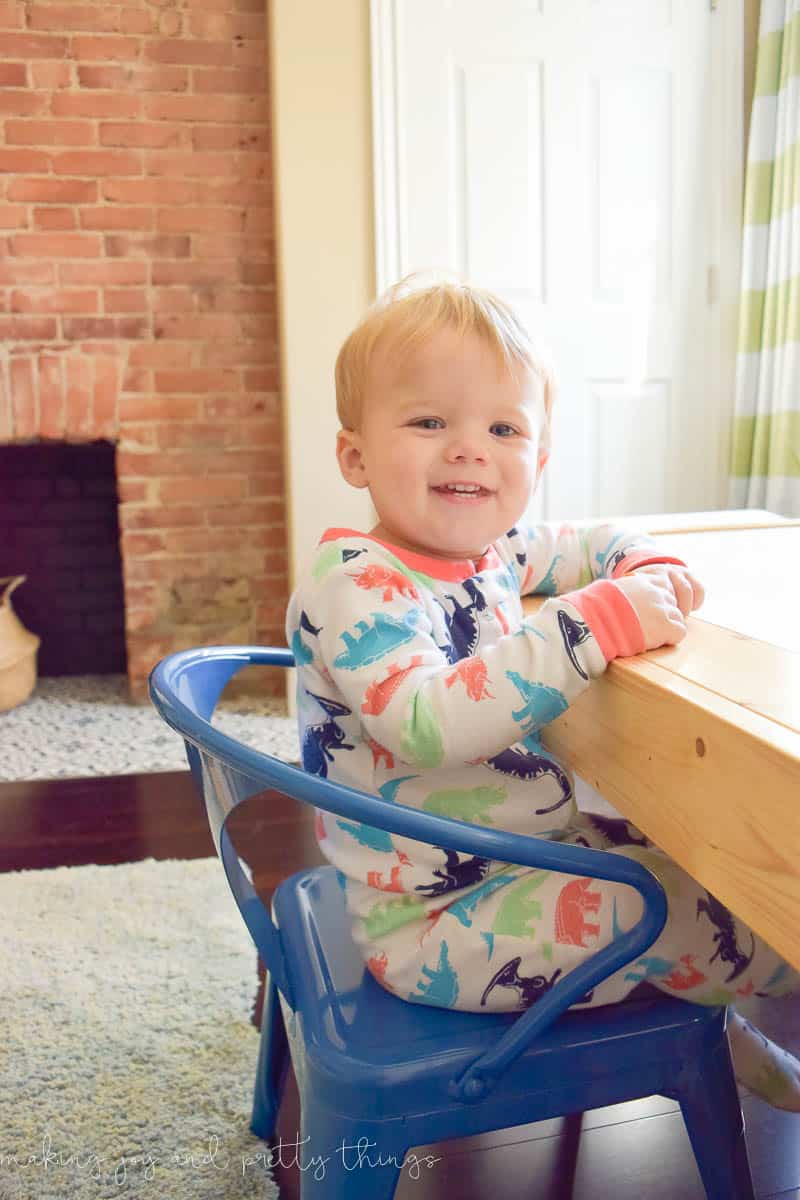
DIY Kids Craft Table
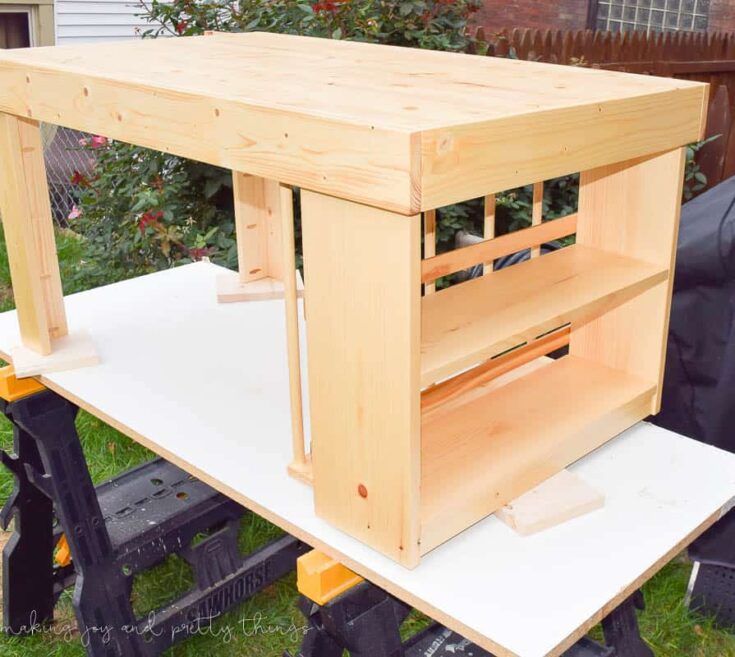
Learn how to make a budget-friendly kids craft table with this tutorial! This crafting table is complete with storage, a bookshelf, and paper holder.
Materials
- 2’ x 4’ preassembled laminated pine project panel (tabletop)
- 1” x 4” pine boards (tabletop apron, legs, book holder, paper holder brackets)
- 3/8” x 1½” pine slats (backstops for storage shelves)
- 1” x 8” pine board (storage shelf assembly)
- 1” x 2” pine board (storage shelf assembly)
- ¾” pine dowe (paper holder)
- ½” pine dowel (book holder)
- ¼” x 1½” poplar slats (paper hold downs)
- ¼” brass threaded inserts (paper hold downs)
- ¼” threaded knobs (paper hold downs)
- Rubber no-slip grips (leg bottoms)
- Titebond interior/exterior wood glue
- Minwax natural wood stain
- Polycrylic satin water-based wood finish
Instructions
- Assemble the tabletop.
- Assemble each component of the table: the table legs, side shelving, book holder, paper holder, and paper hold downs.
- Assemble the table by attaching all of the components to the table top; start with the legs, then attach the side shelves, paper holder, and install the paper hold-downs on the table top.
- Attach no-slip feet to the table.
- Stain if desired.
I’m so excited to have this table for the kiddos and so thankful to have a helpful FIL living so close!
Wishing you a joyful day!
More DIY Crafts to Enjoy:
- Wood Block Crafts: 30+ Genius Ideas
- 29 Easy String Art Ideas You Can Do Yourself
- How To Add Custom Backs To IKEA Pax Wardrobes
- 5 Best Woodworking Tools for Beginners For DIYers
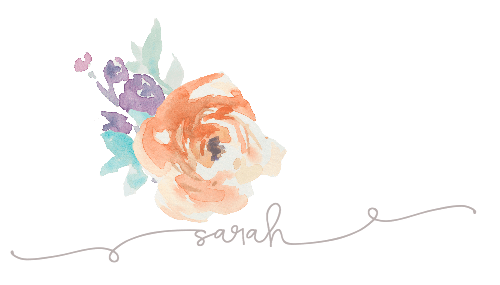
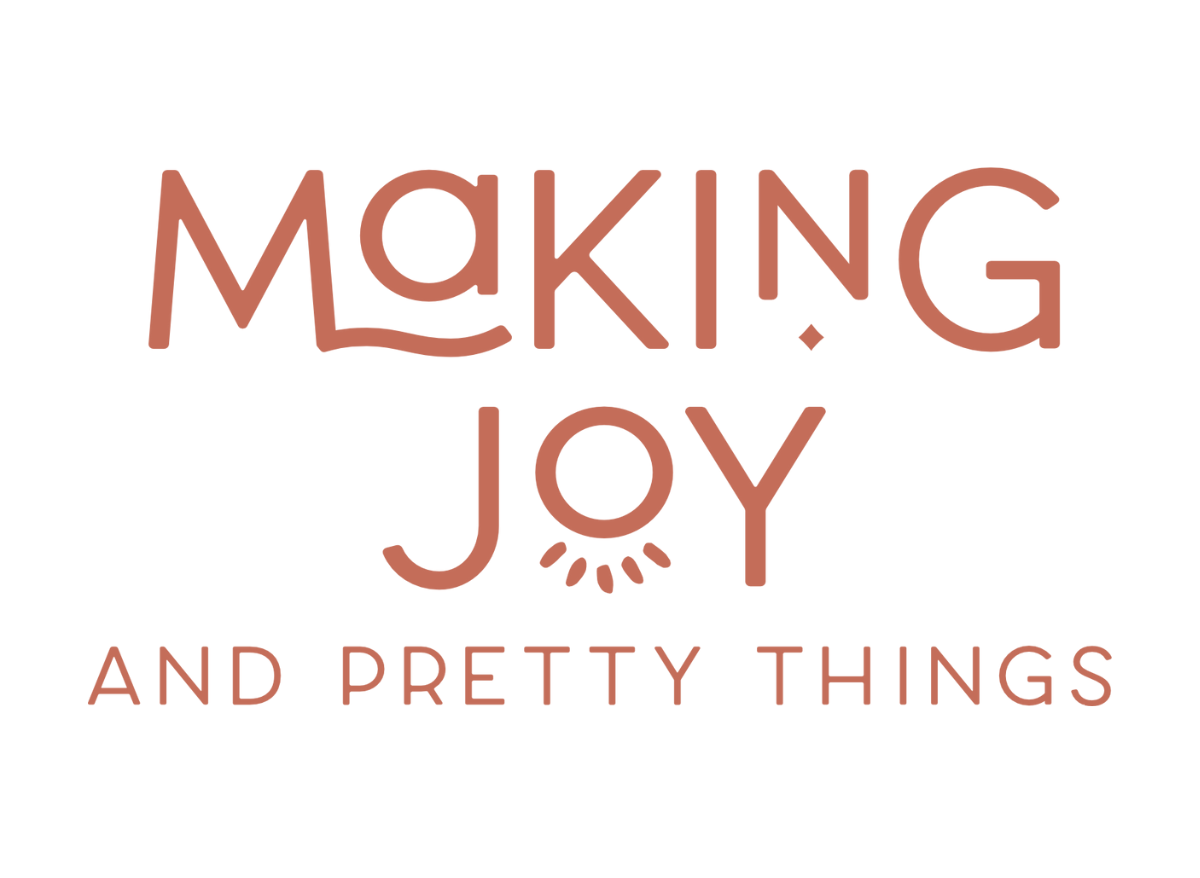
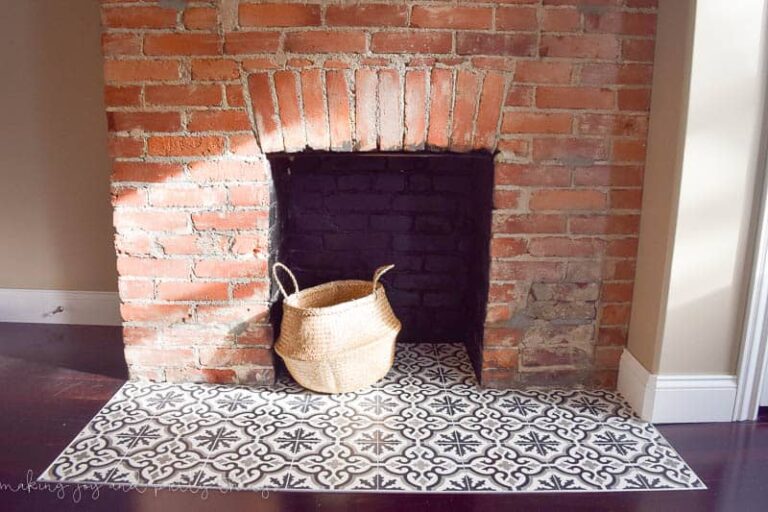
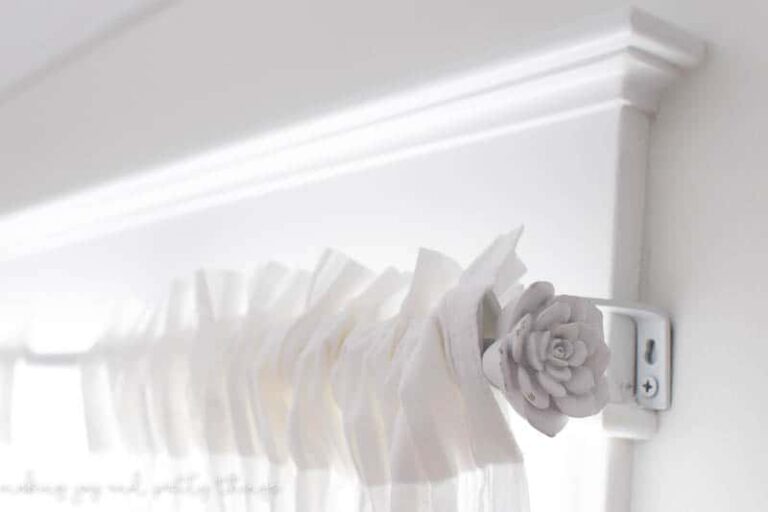
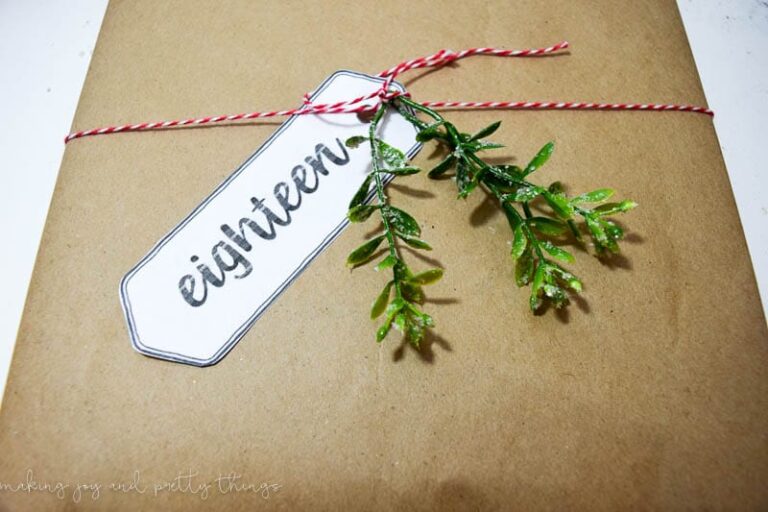
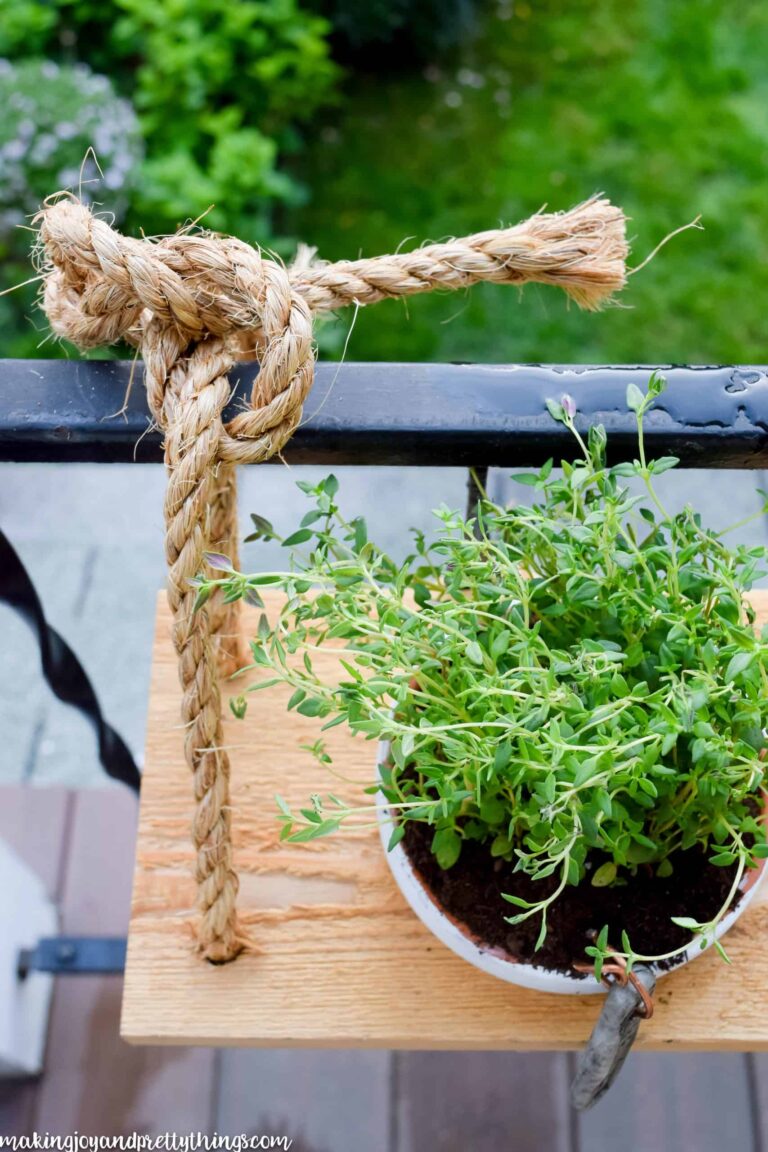
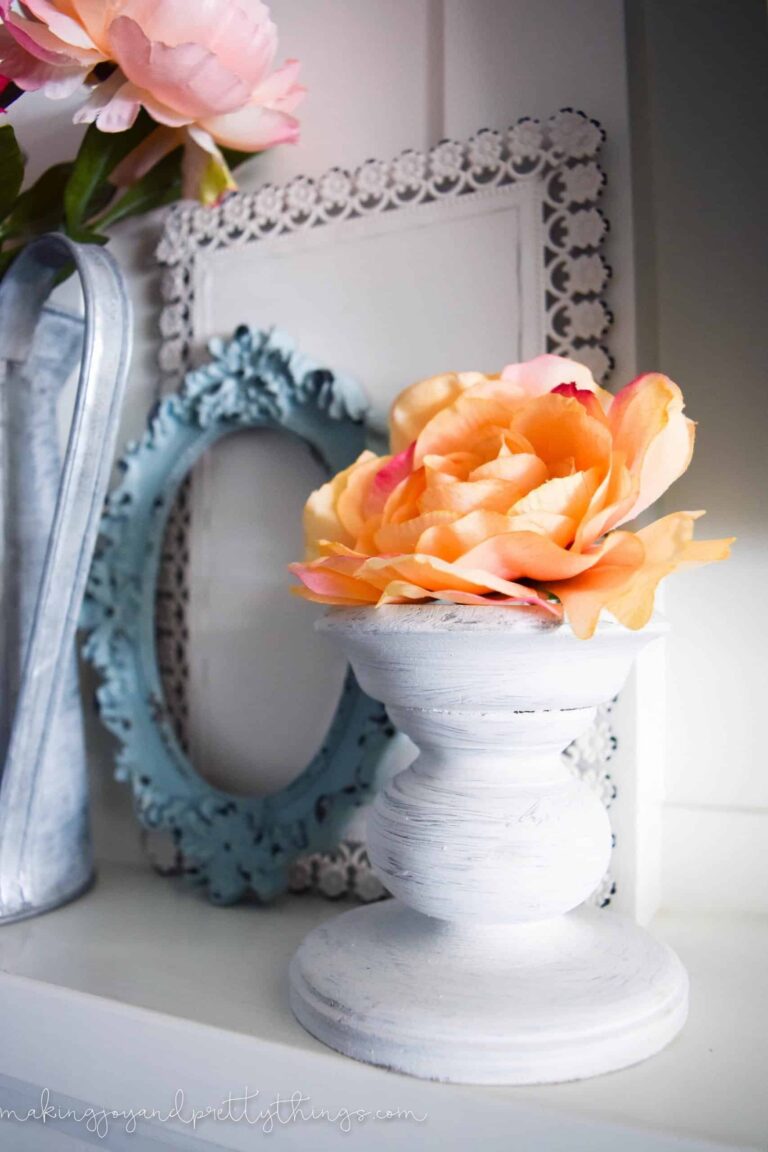
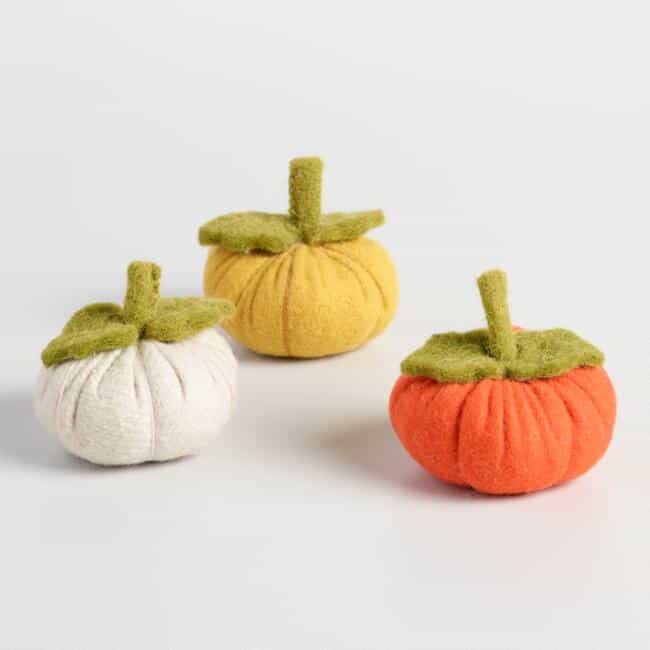
What a fun place to play! It looks great, my toddler would LOVE this!
Thanks Amanda! My kids love to color and draw and it’s open-ended play, which is my favorite!
This table turned out so wonderful! What an amazing and great craft table, no wonder the boys love it. You guys did such an awesome job here!
Thanks, Sabrina!! I can hardly take any credit for the table, except the initial plans. I owe all the hard work to my FIL!
Ha ha, I love his comment about “isn’t everyone” looking to add rustic to their projects. So true with today’s trend. How amazing is it to have him live close by and to help with projects. One of my brothers builds custom cupboards and beds and things of that nature and my brother-in-law, the same. But they are far away so I cannot recruit them! I am really loving the table with all the things kids ‘need’ in one central area. Maybe you all should make a small business out of it. What parent wouldn’t want to buy?:)
Forgot that I also love the chairs from Walmart. Just the right shape and size for kids.
Thank you Zan!! Yeah, he makes fun of me for my farmhouse/rustic style haha. It’s been great to have him living so close and willing to help, though I do feel guilty for asking so often so I’m trying to cut back. My husband actually wants to make a small business out of some of these little projects – so funny you would say that! I’ll have to tell him 🙂 Too bad your BIL and brother live far away!
What an awesome FIL to help you make that table! I wish I had a space I could leave out for the kids to color and keep all their creative making stuff (one day!).
Yes!! He’s been wonderful to have close by, the kids love him. You should make the craft table!!
Adorable table! Amazing design and I know my little ones would have loved it at that age. Great project!
Thank you Amy!! The kids do love their craft table!
I already adored this table when I saw the room makeover! Thank you so much for sharing the how-to!
XO! Vanessa
Aww thanks so much Vanessa! I’m so glad you like the table.
This is awesome! Your kids must love it!
Thanks Michelle!! Yes, my kids absolutely love their little craft table!
What a great craft table and those chairs are adorable! I’ve been thinking of making something similar for our daughters room. When we start building I know where to turn for help! Pinning!
Thanks so much Cat! You should definitely make this craft table! My kiddos love it and I’m sure your daughter will, too!
This is awesome! I’ve been waiting for the details on the table ever since your reveal post in the boys’ room! Of course, I don’t have room for something like it in my tiny house right now. But if and when we ever move, I’ll be sure to build it! Thanks for sharing!
Aww thanks so much Chelsea!! Whenever you have more space you HAVE to make the craft table. It’s actually not very big, more long, I guess? Either way, I’m so glad you like it!
I made a kids table a few years ago and my kids love it! It has been well loved. I really love your book holder and shelf on the side, brilliant!
Aww thanks Kati! I’ll have to check out your table. Our kiddos love their craft table so far. The bookholder and shelves are really what makes it amazing for storage!
Do you have an estimate of the project cost? Definitely adding this to my list of things to make!
Hi Stephanie! We estimated about $50 for the wood and an additional $20 for the baskets and paper roll. We had all the tools, stain and finishing products on hand. Let me know if you have any other questions!
Love this project! Can you tell me where you purchased your paper roll? Trying to find cost/dimensions!
Hi Abbey! I purchased the paper roll at IKEA! I just picked up a new one the other day!
This is awesome!!! And now my husband has been charged with building it as quickly as possible!!
Can you please tell me a few things?
-How thick is the 2’x4′ tabletop? 1/2″? 3/4″?
-What is the height of the table top? I’ve got a tall 3.5 year old and an almost 5 year old, so I want to make sure we don’t build something they will outgrow super fast…
Thanks!!
Hi Dana! The tabletop thickness is 3/4″ (and it comes as a whole piece at Home Depot or another store like that). For the height of the tabletop, I first bought the chairs I wanted to use. Then, we had each of the boys sit in the chair and measure what would be a reasonable height above them for the tabletop to be while sitting in the chairs. We allowed a little more space to account for them growing. But, the idea was that we can take the legs off and build new, taller legs if/when they outgrow the current height. I have an extremely tall 5 year old and average 2.5 year old and ours measures 22″ from the floor to the top of the table. Hope that helps! So excited you’re making the table 🙂
We’re all done! I’d love to send you some pictures of our version but I don’t think it’s an option to add them to my comment here… My boys love it and spend so much time sitting there and now I have my kitchen island back from them!!! 😉
Oh my gosh that’s amazing!!! Yes! Please send me a picture, I’d love to see. Just email me at [email protected] . Cheers to having your kitchen island back!!!
Omg! You have the best father in law! Not only did he bring your ‘blue print’ to life, he wrote the rest of your post! A++
I wish I had those skills or someone in my life with those skills. The table is top notch! Well done 🙂
Hi, wondering if you have a pdf version of thre plans that could be printed off, so that I can make this table for my granddaughter! It’s absolutrly perfect!
Thanks!
No I’m sorry we don’t!